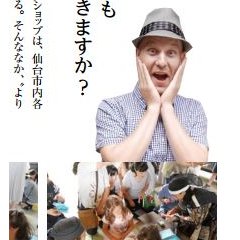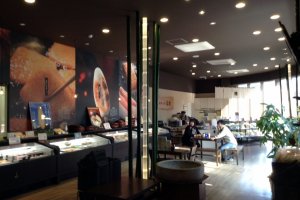As an island nation, it is no surprise that fish and other resources from the sea have been supplementing the Japanese diet since the nation’s earliest inhabitants. Over the years, cooking methods, technology, and a little creativity led to new cuisine items such as Kamaboko, a Miyagi prefecture delicacy. Kamaboko is a pureed fish that is lightly salted, grilled, and made into a cake. It can be mixed with various ingredients and often comes in unique shapes. Perhaps one of the best places to not just learn, but experience Kamaboko is at the Takamasa Onagawa Honten. Located in Ishinomaki, an easy side trip from Sendai, this facility boasts a showroom, factory, and grilling experience.
A ten minute taxi ride from Urashuku station, accessed via the Ishinomaki Line, is the Takamasa Onagawa Honten. Right next to the still beaming 2010 created store and factory is a parking lot for twenty cars and four buses. Walk through the front door to get your fish on. You have obviously entered a store with all these nice packages and price tags with the eager and smiling staff welcoming you with every step closer to a display case. To learn what you are looking at it is probably best to ask to go on a tour. The entrance to the factory is in the back of the store. Just change into the slippers provided and you are ready to go.
The tour makes its way along a long hallway to the end and back, so don’t worry about getting lost or having to do much walking. Your pamphlet is in Japanese and English and explains the entire process how fish are caught, deboned, boiled, chopped, mashed, and all that good stuff to get it into the fish cake we are all too familiar with here in Miyagi. Many shops have their own versions. Sendai’s Kamaboko is known as Sasakamaboko. It is more or less the same as regular Kamaboko but its shape is a “sasa” or bamboo leaf. Viewing through the factory windows you will see the Japanese spirit of hardworking employees in perfect unison working with western-influenced technology. See Kamaboko go from a blob of fish dough, to small blob, to small blob on a stick, to roasted small blob on a stick, to small cooked cake off a stick in plastic wrapping. A store staff member comes in while you are viewing to explain the company’s history, products, and all the finer points of Kamaboko production. Even if you have no Japanese ability, the pamphlet explains enough and seeing the machinery moving is really interesting. A packing room is also viewable with workers moving as fast and continuous as conveyor belt sushi.
Next you can should try grilling your own Kamaboko. You weren’t really going to come here and not sample your own cooked cuisine were you? And the company knows visitors would have this mindset, thus they have lock downed an area with several cooking tables. While grilling your Kamaboko, samples of the company’s products are often handed out and a staff member talks about the tsunami that devastated Ishinomaki and the entire northeastern region of Japan. A video screen shows images from that tragic day. Drown your depression in a hot fish cake. Add a little salt or pepper and take a bite. Yes, it tastes a bit fishy. Eggs, meat, cheese, or almost anything could be added to Kamaboko, so if you weren’t happy with your plain version cooking you should browse the factory store.
Gift sets galore and Kamaboko fill the shelves of Takamasa Onagawa Honten. Try some free samples, chat up the staff about Kamaboko or the fishing town’s history, and maybe pick up a souvenir before heading out for you next adventure.

































